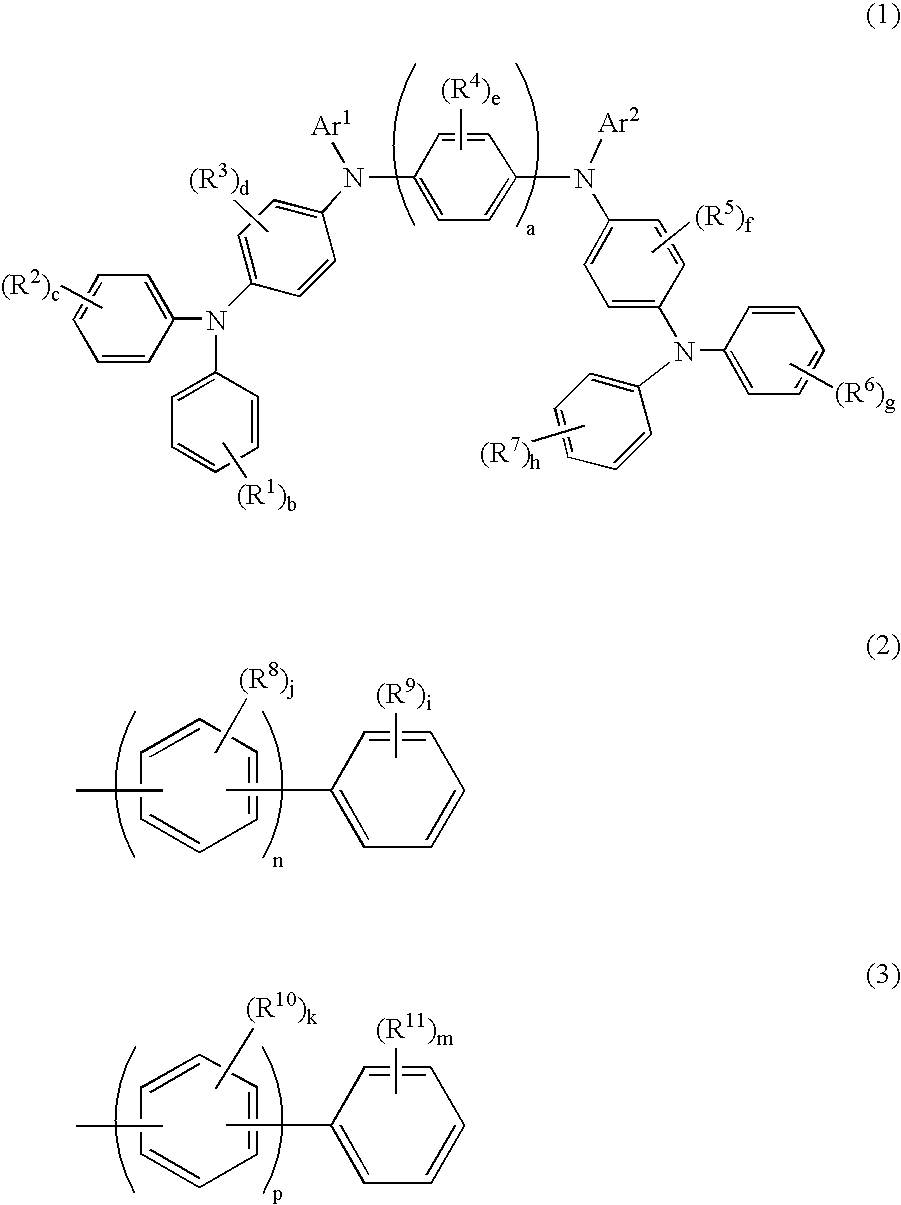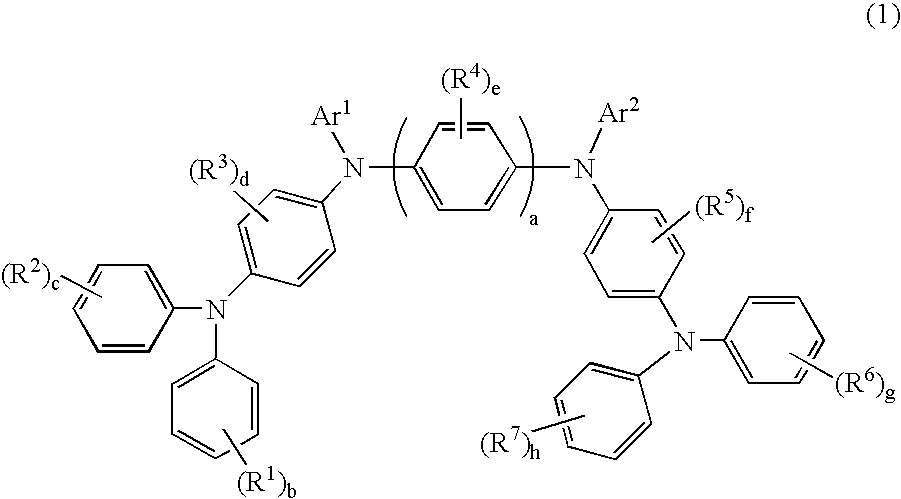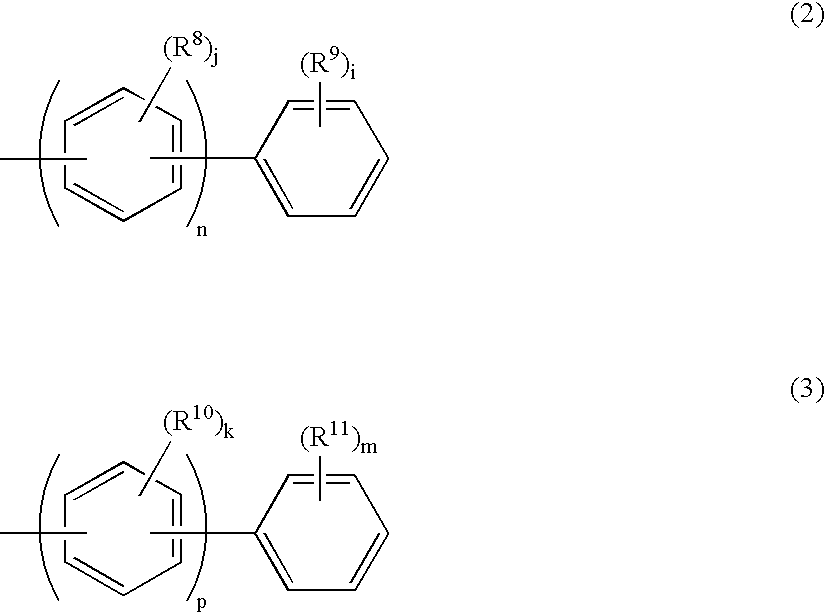Aromatic amine derivative and organic electroluminescence device using the same
an organic electroluminescence and amine technology, applied in the direction of organic semiconductor devices, organic chemistry, triarylamine dyes, etc., can solve the problems that the above-mentioned amine derivatives do not sufficiently meet the above requirements, and achieve the effect of small increase in driving voltage and long li
- Summary
- Abstract
- Description
- Claims
- Application Information
AI Technical Summary
Benefits of technology
Problems solved by technology
Method used
Image
Examples
synthesis example 1
Synthesis of Compound (1)
[0146]Compound (1) was synthesized in accordance with the following scheme:
(1) Synthesis of Intermediate 3
[0147]Under a stream of argon, Intermediate 1 (5.7 g), Intermediate 2 (10.0 g), K2CO3 (11.8 g), N,N′-dimethylethylenediamine (0.86 g), CuI (0.82 g) and 100 ml of dehydrated xylene were placed into a reactor, and the reaction was allowed to proceed by heating the resulting mixture under the refluxing condition for 3 days. When the reaction was completed, the reaction mixture was cooled, and the insoluble component was separated. The separated insoluble component was washed with methylene chloride and toluene, and 10.3 g of Intermediate 3 was obtained (the yield: 79%). The obtained product was identified to be Intermediate 3 in accordance with the field desorption mass spectroscopy (FD-MS).
(2) Synthesis of Intermediate 6
[0148]Under a stream of argon, acetanilide (2.8 g), Intermediate 5 (28.0 g), K2CO3 (16.8 g), N,N′-dimethylethylenediamine (1.1 g), CuI (1....
synthesis example 2
Synthesis of Compound (2)
(1) Synthesis of Intermediate 8
[0152]Intermediate 8 was synthesized in accordance with the same procedures as those conducted in Synthesis Example 1 (2) except that Intermediate 7 was used in place of Intermediate 5 used in Synthesis Example 2 (2).
(2) Synthesis of Intermediate 11
[0153]Intermediate 11 was synthesized in accordance with the same procedures as those conducted in Synthesis Example 1 (3) except that Intermediate 8 was used in place of Intermediate 6 used in Synthesis Example 1 (3).
(3) Synthesis of Intermediate 14
[0154]Intermediate 14 was synthesized in accordance with the same procedures as those conducted in Synthesis Example 1 (4) except that Intermediate 11 was used in place of Intermediate 9 used in Synthesis Example 1 (4).
(4) Synthesis of Compound (2)
[0155]In accordance with the same procedures as those conducted in Synthesis Example 1 (5) 5 except that Intermediate 14 was used in place of Intermediate 12 used in Synthesis Example 1 (5), 8.9...
synthesis example 3
Synthesis of Compound (3)
(1) Synthesis of Intermediate 10
[0156]Intermediate 10 was synthesized in accordance with the same procedures as those conducted in Synthesis Example 1 (3) except that Intermediate 4 was used in place of Intermediate 3 used in Synthesis Example 1 (3).
(2) Synthesis of Intermediate 13
[0157]Intermediate 13 was synthesized in accordance with the same procedures as those conducted in Synthesis Example 1 (4) except that Intermediate 10 was used in place of Intermediate 9 used in Synthesis Example 1 (4).
(3) Synthesis of Compound (3)
[0158]In accordance with the same procedures as those conducted in Synthesis Example 1 (5) except that Intermediate 13 was used in place of Intermediate 12 used in Synthesis Example 1 (5), 9.1 g of a powder substance was obtained. The obtained substance was identified to be Compound (3) expressed by the following formula in accordance with FD-MS.
PUM
| Property | Measurement | Unit |
|---|---|---|
| Electric potential / voltage | aaaaa | aaaaa |
| Electric potential / voltage | aaaaa | aaaaa |
| Electric potential / voltage | aaaaa | aaaaa |
Abstract
Description
Claims
Application Information
 Login to View More
Login to View More - R&D
- Intellectual Property
- Life Sciences
- Materials
- Tech Scout
- Unparalleled Data Quality
- Higher Quality Content
- 60% Fewer Hallucinations
Browse by: Latest US Patents, China's latest patents, Technical Efficacy Thesaurus, Application Domain, Technology Topic, Popular Technical Reports.
© 2025 PatSnap. All rights reserved.Legal|Privacy policy|Modern Slavery Act Transparency Statement|Sitemap|About US| Contact US: help@patsnap.com



